| کد مقاله | کد نشریه | سال انتشار | مقاله انگلیسی | نسخه تمام متن |
|---|---|---|---|---|
| 5863866 | 1135622 | 2014 | 8 صفحه PDF | دانلود رایگان |
ObjectiveThe purpose of this study was to compare the spine flexion angle time histories computed with the 2 described techniques (dot product [DP] and a modified joint coordinate system [JCS] approaches) that used vector algebra and used skin-mounted markers to the spine flexion angles derived using local coordinate systems constructed from rigid bodies affixed to the pelvis and thorax during spine flexion movements.MethodsDiscrepancies between the simplified marker setup and a criterion standard (CS) method for measuring spine kinematics were quantified. Sixteen participants performed full forward spine flexion. Three-dimensional kinematic data were obtained from markers affixed bilaterally over the greater trochanters, iliac crests, and 10th ribs. Time varying spine flexion angles were derived from the 3-, and 2-dimensional marker data using a DP and a modified JCS approach. Criterion standard spine kinematics were obtained from clusters of markers adhered to 2 rigid fins that were affixed over the pelvis and trunk. The DP and JCS methods were compared with the CS by computing root mean squared differences and correlations during the spine flexion trials. Descriptive measurements of missing kinematic data were also obtained.ResultsOn average, root mean squared differences were 30.1% lower for the JCS method of deriving spine flexion angles. Correlations were also higher for the JCS method by 2.5%, compared with the DP method.ConclusionThe findings suggest that the adapted JCS method is superior to the DP method for deriving spine flexion angles. This is especially true when only 2-dimensional coordinate data are available.
Journal: Journal of Manipulative and Physiological Therapeutics - Volume 37, Issue 9, NovemberâDecember 2014, Pages 688-695
